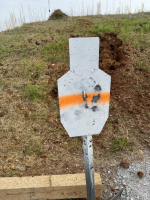I am now 90% convinced that lubing the necks has a noticeable impact on consistency. A couple weeks ago, I tested lubed necks vs. non-lubed necks with my 300 PRC at just under 500 yards. I had expected some SD improvement for lube, and got a little, but I did not expect a significant dispersion improvement at these distances.
I was wrong. Two weeks ago, I found the dispersion on non-lubed necks was significantly larger. However, it was at or under 15 shots per test group, so I wanted to retest. I ended up loading 25+ of each and went back out to the hills yesterday to shoot 15 of each at 450 yards for group size and 10+ at a mile. I got almost identical results.
For both tests
- Both showed a slight increase in SDs for non-lubed cases (1-2 fps). HOWEVER, I'm not ready to conclusively say that this isn't just due to margin of error stuff.
- The biggest impact was on group size - significantly better for lubed case necks across both sets of tests.
Below are the targets showing the results from two weeks ago (left image on each) and yesterday (right image on each). For those who are interested, a bottlecap is indeed 1 inch - drove to the target and forgot to bring a 1-inch anything, so found a bottlecap in my Jeep and used that.
Lubed cases:
View attachment 8400852 Non-lubed cases:
View attachment 8400860 You can see that in both tests the group size for lubed case necks is significantly better, especially when you consider that for lubed cases, the vast majority of the shots fall into about a half-moa group size on each and it was only 2 shots (two weeks ago) and 1 shot (yesterday) that caused the group size to double.
I'm working on a video to document this.


